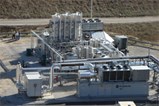GE Energy's Jenbacher Engine Powers Commercial Landfill Gas Conversion Plant To Supply Fuel For Public Vehicles

 Atlanta, GA - A GE Energy ecomagination-certified Jenbacher landfill gas engine is powering the commercial landfill gas (LFG)-to-liquid natural gas (LNG) conversion facility designed to create alternative fuel for vehicles. The LNG produced at the new facility is primarily targeted to be used as fuel for mass transit and other large vehicle fleets in the Los Angeles, Calif. region.
Atlanta, GA - A GE Energy ecomagination-certified Jenbacher landfill gas engine is powering the commercial landfill gas (LFG)-to-liquid natural gas (LNG) conversion facility designed to create alternative fuel for vehicles. The LNG produced at the new facility is primarily targeted to be used as fuel for mass transit and other large vehicle fleets in the Los Angeles, Calif. region.
According to the federal Landfill Methane Outreach Program (LMOP), a project of this size provides annual emissions benefits equivalent to removing more than 125,000 vehicles, or displacing the use of more than 71,500,000 gallons of gasoline. LMOP was established by the U.S. Environmental Protection Agency to reduce methane emissions from municipal solid waste landfills by supporting LFG-to-energy projects.
Seattle, Washington-based alternative energy company Prometheus Energy Company built the break-through landfill gas conversion facility at the Frank R. Bowerman Landfill, located in Irvine, Orange County, approximately 40 miles south of Los Angeles.
The project is now in the commissioning phase, with the Jenbacher engine already supplying power. GE's Jenbacher unit is a JGC 320 GS-L.L system – utilizing process waste gas and landfill gas to support the LFG-to-LNG facility's operations. The electricity generated by the gas engine is primarily used in the gas compression and liquefaction stages of the LNG production process. Smith Power Products, GE's U.S. intermountain regional authorized Jenbacher engine distributor, has been deeply involved in the project's development with GE's West Coast Jenbacher engine distributor, Western Energy Systems, which will be responsible for after-sales service.
GE's scope of supply includes the patented Jenbacher CL.AIR exhaust gas treatment system. By utilizing Jenbacher's CL.AIR system – a non-catalytic exhaust gas treatment system – the gas engine CO emissions are reduced by more than 80%.
The treatment facility will initially produce approximately 5,000 gallons of LNG per day and, at full build-out, will produce more than 36,000 gallons of LNG per day, with a methane content of 97% or greater. The feasibility of converting landfill gas-to-LNG can be attributed in large part to key technological advancements. While processes for purifying landfill gas are well-proven, Prometheus has a unique, proprietary method for removing CO2 through cryogenic separation.
"We are proud to collaborate with Prometheus Energy on this landmark landfill gas-mass transit initiative," said Prady Iyyanki, CEO of GE Energy's Jenbacher gas engines division. "This project is designed to offer significant environmental and economic benefits to Orange County and the entire state."
Prometheus CEO Kirt W. Montague added, "As part of our ongoing commitment to environmental stewardship, Prometheus chose GE's Jenbacher engine based on its ability to meet some of the most stringent air quality standards in the country. We look forward to a long and mutually beneficial relationship with GE Energy as we build out this exciting project."
In addition to improving air quality and reducing the consumption of traditional natural gas for mass transit, refuse hauling fleets and other LNG vehicle fleets, the project also greatly reduces the fuel transportation cost and the distance over which LNG must be transported to customers. Existing, conventional LNG supply sources are located as far as 840 miles away from customers in Southern California.
The Bowerman landfill is owned and operated by the Orange County Integrated Waste Management Department. Montauk Energy Capital, through its subsidiary GSF Energy, operates the landfill's methane gas collection system.
Based in Jenbach, Austria, GE's Jenbacher gas engine business is a leading manufacturer of gas-fueled reciprocating engines, packaged generator sets and cogeneration systems for power generation. GE's Jenbacher gas engines run on natural gas or a variety of specialty waste gases, including landfill gas.
SOURCE: GE Energy
